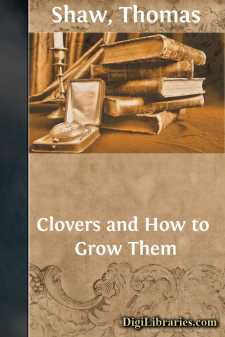Categories
- Antiques & Collectibles 13
- Architecture 36
- Art 48
- Bibles 22
- Biography & Autobiography 813
- Body, Mind & Spirit 142
- Business & Economics 28
- Children's Books 17
- Children's Fiction 14
- Computers 4
- Cooking 94
- Crafts & Hobbies 4
- Drama 346
- Education 46
- Family & Relationships 57
- Fiction 11829
- Games 19
- Gardening 17
- Health & Fitness 34
- History 1377
- House & Home 1
- Humor 147
- Juvenile Fiction 1873
- Juvenile Nonfiction 202
- Language Arts & Disciplines 88
- Law 16
- Literary Collections 686
- Literary Criticism 179
- Mathematics 13
- Medical 41
- Music 40
- Nature 179
- Non-Classifiable 1768
- Performing Arts 7
- Periodicals 1453
- Philosophy 64
- Photography 2
- Poetry 896
- Political Science 203
- Psychology 42
- Reference 154
- Religion 513
- Science 126
- Self-Help 84
- Social Science 81
- Sports & Recreation 34
- Study Aids 3
- Technology & Engineering 59
- Transportation 23
- Travel 463
- True Crime 29
Clovers and How to Grow Them
by: Thomas Shaw
Categories:
Description:
Excerpt
CHAPTER I
INTRODUCTORY
In this book all the varieties of clover will be discussed that have hitherto been found of any considerable value to the agriculture of America. Varieties that are of but little value to the farmer will be discussed briefly, if discussed at all. The discussions will be conducted from the standpoint of the practical agriculturist rather than from that of the botanist. It is proposed to point out the varieties of clover worthy of cultivation, where and how they ought to be cultivated, and for what uses.
Definition of Clover.—According to Johnson's Encyclopædia, clover or trefoil is a plant of the genus Trifolium and the family Leguminosæ. The Standard Dictionary defines it as any one of several species of plants of the genus Trifolium of the bean family Leguminosæ. Viewed from the standpoint of the American farmer it may be defined in the collective sense as a family of plants leguminous in character, which are unexcelled in furnishing forage and fodder to domestic animals, and unequaled in the renovating influences which they exert upon land. The term Trefoil is given because the leaves are divided into three leaflets. It is also applied to plants not included in the genus, but belonging to the same order.
The true clovers have their flowers collected into roundish or oblong heads and in some instances into cone-shaped spikes. The flowers are small and of several colors in the different varieties, as crimson, scarlet, pink, blue, yellow and white, according to the variety, and some are variously tinted. The stems are herbaceous and not twining. The seeds are inclosed in pods or seed sacks, each of which contains one, two and sometimes, but not often, three or four seeds. The plants have tap roots, and in some varieties these go far down into the subsoil. The roots are also in some varieties considerably branched.
Varieties.—At least twenty varieties, native or naturalized, are found in Great Britain; more than twelve varieties belong to the United States. The more valuable varieties found in this country have been introduced from Europe, unless it be the small white clover (Trifolium repens). Viewed from the standpoint of the agriculturist the varieties that are most generally useful include medium red clover (Trifolium pratense), alfalfa (Medicago sativa), alsike (Trifolium hybridum), mammoth (Trifolium magnum), crimson (Trifolium incarnatum) and small white (Trifolium repens). The varieties which flourish only in the South include the Japan (Lespedeza striata) and the burr clover (Medicago denticulata). Sweet clover (Melilotus alba), sometimes called Bokhara, which will grow equally well North and South, is worthy of attention because of its power to grow under hard conditions, in order to provide honey for bees and to renovate soils. Other varieties may render some service to agriculture, but their value will not compare with that of the varieties named.
The most valuable of the varieties named in providing pasture, include the medium red, the mammoth, the alsike and the small white. The most valuable in providing hay are the medium red, alfalfa and alsike. The most valuable, viewed from the standpoint only of soil renovation, are the medium red, mammoth, alsike, crimson, Japan and sweet. The most valuable in producing honey accessible to tame bees, are the small white, alsike and sweet.
Distinguishing Characteristics.—Clovers differ from one another in duration, habit of growth, persistence in growth, their power to endure low or warm temperatures, and ability to maintain a hold upon the soil. Of the varieties named, alfalfa, the small white and alsike varieties are perennial. That most intensely so is the first variety named. The medium red and mammoth varieties are biennial, but sometimes they assume the perennial quality. Sweet clover is biennial. The crimson, Japan and burr varieties are annual.
Some varieties, as alfalfa, crimson and sweet clover, are upright in their habit of growth. Others, as the small white and the burr, are recumbent. Others again, as the medium red, alsike and mammoth, are spreading and upright. The alfalfa and medium red varieties grow most persistently through the whole season. The sweet, small white and alsike varieties can best endure cold, and the sweet, Japan and burr varieties can best endure heat....


